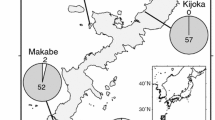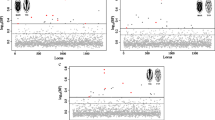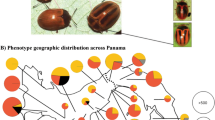Abstract
The hermaphroditic terrestrial snail Rumina decollata has a mixed breeding system with a high prevalence of self-fertilization. In the Montpellier area (France), the species is represented by a dark and a light color morph. Based on allozyme data, both morphs have been reported as single, homozygous multilocus genotypes (MLG), differing at 13 out of 26 loci, but still showing occasional hybridization. Recent DNA sequence data suggest that each morph is a different phylogenetic species. In order to further evaluate this new taxonomic interpretation, the present contribution explores to what extent populations or color morphs indeed consist of single or few MLG. As such it is shown that both morphs are not single, homozygous MLG, but instead reveal a considerable amount of allelic variation and substantial numbers of heterozygous microsatellite genotypes. This suggests that outcrossing may be more prevalent than previously reported. Nevertheless, both morphs maintain a diagnostic multimarker differentiation in the presence of outcrossing in sympatric conditions, implying that they may be interpreted as species under the biological species concept. Finally, our data challenge the idea that simultaneous hermaphrodites should be either strict selfers or strict outcrossers.



Similar content being viewed by others
References
Backeljau T (1987) Electrophoretic distinction between Arion hortensis, A. distinctus and A. owenii (Mollusca: Pulmonata). Zool Anz 219:33–39
Backeljau T, Breugelmans K, Leirs H, Rodriguez T, Sherbakov D, Sitnikova T, Timmermans JM, Van Goethem JL, Verheyen E (1994) Application of isoelectric focusing in molluscan systematics. The Nautilus 2:156–167
Backeljau T, de Bruyn L, De Wolf H, Jordaens K, Van Dongen S, Winnepenninckx B (1997) Allozyme diversity in slugs of the Carinarion complex (Mollusca, Pulmonata). Heredity 78:445–451
Batts JH (1957) Anatomy and life cycle of the snail Rumina decollata (Pulmonata: Achatinidae). Southw Nat 2:74–82
Belkhir K, Borsa P, Chikhi L, Raufaste N, Bonhomme F (1996) GENETIX 4.05, logiciel sous WindowsTM pour la génétique des populations. Laboratoire Génome, Populations, Interactions, Université de Montpellier II, Montpellier (France)
Chapuis MP, Estoup A (2007) Microsatellite null alleles and estimation of population differentiation. Mol Biol Evol 24:621–631
Chiba S (2003) Species diversity and conservation of Mandarina, an endemic land snail of the Ogasawara Islands. Global Environ Res 7:29–37
Dakin EE, Avise JC (2004) Microsatellite null alleles in parentage analysis. Heredity 93:504–509
David P, Pujol B, Viard F, Castella V, Goudet J (2007) Reliable selfing rate estimates from imperfect population genetic data. Mol Ecol 16:2474–2487
Dundee D (1986) Notes on the habits and anatomy of the introduced land snails, Rumina and Lamellaxis (Subulinidae). The Nautilus 100:32–37
Escobar JS, Auld JR, Correa AC, Alonso JM, Bony YK, Coutellec M-A, Koene JM, Pointier J-P, Jarne P, David P (2011) Patterns of mating-system evolution in hermaphroditic animals: correlations among selfing rate, inbreeding depression, and the timing of reproduction. Evolution 65:1233–1253
Foltz DW, Schaitkin BM, Selander RK (1982) Gametic disequilibrium in the self-fertilizing slug Deroceras laeve. Evolution 36:80–85
Geenen S, Jordaens K, Castilho R, Backeljau T (2003) Congruence between starch gel and polyacrylamide gel electrophoresis in detecting allozyme variation in pulmonate land slugs. Electrophoresis 24:622–627
Geenen S, Jordaens K, Backeljau T (2006) Molecular systematics of the Carinarion complex (Mollusca: Gastropoda: Pulmonata): a taxonomic riddle caused by a mixed breeding system. Biol J Linn Soc 89:589–604
Giokas S, Mylonas M, Sotiropoulos K (2000) Gene flow and differential mortality in a contact zone between two Albinaria species (Gastropoda; Clausiliidae). Biol J Linn Soc 71:755–770
Goodwillie C, Kalisz S, Eckert CG (2005) The evolutionary enigma of mixed mating systems in plants: occurrence, theoretical explanations, and empirical evidence. Annu Rev Ecol Syst 36:47–79
Goudet J (2001) FSTAT, a program to estimate and test gene diversities and fixation indices (version 2.9.3). Available from http://www2.unil.ch/popgen/softwares/fstat.htm
Harris H, Hopkinson DA (1976) Handbook of enzyme electrophoresis in human genetics. North Holland Publishing Company, Amsterdam
Jarne P, Auld JR (2006) Animals mix it up too: the distribution of self-fertilization among hermaphroditic animals. Evolution 60:1816–1824
Jordaens K, Geenen S, Reise H, Van Riel P, Verhagen R, Backeljau T (2000) Is there a geographical pattern in the breeding system of a complex of hermaphroditic slugs (Mollusca: Gastropoda: Carinarion)? Heredity 85:571–579
Lance SL, Jones KL, Hagen C, Jordaens K, Backeljau T, Prévot V (2010) Fifteen microsatellite loci for the decollate snail, Rumina decollata. Conserv Genet Resour 2:287–289
Mayr E (1970) Populations, species, and evolution. Harvard University Press, Cambridge
Nei M (1978) Estimation of average heterozygosity and genetic distance from a small number of individuals. Genetics 89:583–590
Nicklas NL, Hoffman RJ (1981) Apomictic parthenogenesis in a hermaphroditic terrestrial slug, Deroceras laeve (Müller). Biol Bull 160:123–135
Prévot V, Jordaens K, Sonet G, Backeljau T (2013) Exploring species level taxonomy and species delimitation methods in the facultatively self-fertilizing land snail genus Rumina (Gastropoda: Pulmonata). PLoS ONE 8(4):e60736. doi:10.1371/journal.pone.0060736
Raymond M, Rousset F (1995) GENEPOP (version 1.2): population genetics software for exact tests and ecumenicism. J Hered 86:248–249
Rice WR (1989) Analyzing tables of statistical tests. Evolution 43:223–225
Selander RK, Hudson RO (1976) Animal population structure under close inbreeding: the land snail Rumina in southern France. Am Nat 110:695–718
Selander RK, Kaufman DW (1973) Self-fertilization and genetic population structure in a colonizing land snail. Proc Natl Acad Sci USA 70:1186–1190
Selander RK, Ochman H (1983) The genetic structure of populations as illustrated by molluscs. Isozymes: Curr Top Biol Med Res 10: Genet Evol: 93–123
Selander RK, Kaufman DW, Ralin RS (1974) Self-fertilization in the terrestrial snail Rumina decollata. The Veliger 16:265–270
Tamura K, Dudley J, Nei M, Kumar S (2007) MEGA4: molecular evolutionary genetics analysis (MEGA) software version 4.0. Mol Biol Evol 24:1596–1599
Viard F, Justy F, Jarne P (1997) The influence of self-fertilization and population dynamics on the genetic structure of subdivided populations: a case study using microsatellite markers in the freshwater snail Bulinus truncatus. Evolution 51:1518–1528
Weir BS, Cockerham CC (1984) Estimating F-statistics for the analysis of population structure. Evolution 38:1358–1370
Woodruff DS, Gould SJ (1987) Fifty years of interspecific hybridization: genetics and morphometrics of a controlled experiment involving the land snail Cerion in Florida. Evolution 41:1022–1045
Wright S (1943) Isolation by distance. Genetics 28:114–138
Wright S (1978) Evolution and the genetics of populations. University of Chicago Press, Chicago
Yeh FC, Yang R-C, Boyle TBJ, Ye Z-H, Mao XJ (1997) POPGENE, the user-friendly shareware for population genetic analysis. University of Alberta, Canada, Molecular Biology and Biotechnology Centre
Acknowledgments
We are indebted to all the persons who collected specimens and helped us in various ways, as well as to Claúdia Patrão (University of Algarve, Portugal), Dr. Patrick Mardulyn (Free University of Brussels, Belgium) and to the Botanical Garden from the University of Montpellier. V. Prévot was a PhD fellow at the FNRS (Belgium). Financial support was provided by the “Fonds David et Alice Van Buuren” to VP and by BELSPO Action 1 project MO/36/017 to TB. This work was conducted within the framework of the BELSPO IUAP program “SPEEDY” and the FWO research community BeBOL.
Author information
Authors and Affiliations
Corresponding author
Electronic supplementary material
Below is the link to the electronic supplementary material.
Rights and permissions
About this article
Cite this article
Prévot, V., Jordaens, K., Van Houtte, N. et al. Taxonomic and population genetic re-interpretation of two color morphs of the decollate snail, Rumina decollata (Mollusca, Pulmonata) in southern France. Genetica 141, 281–292 (2013). https://doi.org/10.1007/s10709-013-9727-4
Received:
Accepted:
Published:
Issue Date:
DOI: https://doi.org/10.1007/s10709-013-9727-4




